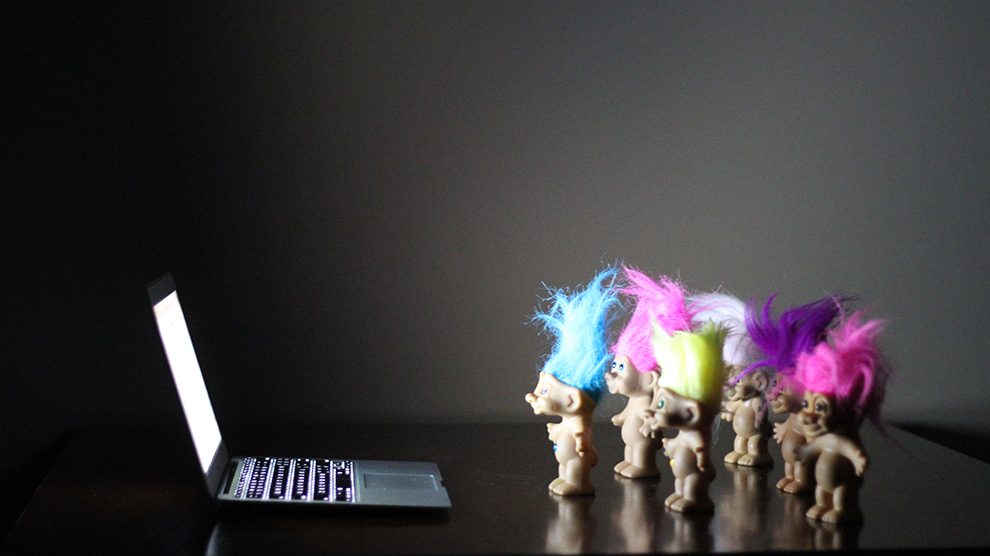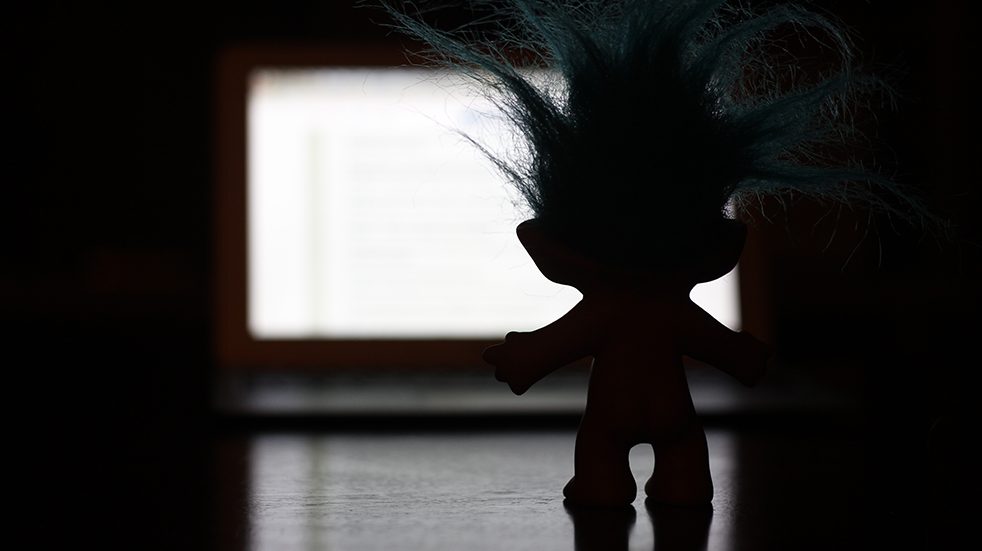The trouble with trolls

caption
Journalists search for how to best survive troll attacks
One Friday last year, Julie DiCaro didn’t go to work. She wasn’t sick, wasn’t taking a vacation day, and wasn’t playing hooky. DiCaro didn’t go to work because she didn’t feel safe. She had received a threat. The following Monday she donned a hoodie, large sunglasses, and made her way to work. Catching a glimpse of herself, she thought, “This is insane.”
DiCaro, an anchor for Chicago radio station 670 The Score and a freelance sportswriter was – and frequently is – harassed online. This is otherwise known as being trolled.
Dr. Michael Nuccitelli, a New York psychologist who has studied and written about trolls, says there are two types: classic trolls and predatory trolls (the latter evolve from the former). Trolls, he says, “are now beginning to target aspects of the journalist’s life that is no longer just the journalist.” They go deeper than a mild insult in an online comment section. They will attack your family, your sources, your employer, and they rarely work alone.
For the classic troll the “don’t feed the trolls” mantra will usually work – they will hopefully move on – but not feeding predatory trolls will only enlist them to attack more.
A 2014 University of Manitoba study revealed that trolls show high rates of psychopathic, sadistic and narcissistic behaviour. In other words, journalists need to be careful with trolls. “Don’t defame the defamer,” Dr. Nuccitelli said. “Take the high road.” He suggests that journalists do what they do best: create an articulate response, and then expose the trolls.
Journalists are no strangers to people criticizing their work, or even making the occasional personal attack. Readers of a newspaper could always take up pen and paper, say what they needed to say, and mail a letter to the editor. The possibility of audience-to-journalist dialogue was, however, impeded by snail mail. Harassment existed, maybe through a phone call, but as the Internet took off like a jet plane, turned rocket ship, turned speed-of-light spaceship, journalists; online presence has made them more accessible and vulnerable.

caption
Predatory trolls often work in groups.Gone are the days when a journalist could simply omit a phone number from the phonebook. With the rise of social media, the barrier between journalist and audience has been torn down. To all trolls’ delight, the current journalist is advised to be present on all platforms of social media and the Internet: Twitter, Facebook, personal websites, Instagram. For many journalists, shutting down profiles would hurt their career.
Michelle Ferrier, an associate professor at the E.W. Scripps School of Journalism of Ohio University, says if journalists had dealt with trolls when they were created – or at least acknowledged their existence – there might be a “more digital-savvy journalistic workforce” when it comes to dealing with trolls. Finding a way to effectively combat trolls has proved difficult. In January 2015, with hopes of finding a solution, Ferrier founded TrollBusters.
The website operates in two ways: reactively and proactively. If a journalist has been trolled, they report it on the website and their social media page is then flooded with positive messages sent from the people at TrollBusters. Ferrier says this is an “emotional hedge of protection.” TrollBusters also sends out tips on how to fight trolls, with a focus of helping targets maintain their online presence.
TrollBusters can be particularly helpful for freelancers who don’t necessarily have a media organization to back them up. Ferrier suggests that freelancers not only negotiate things like pay, but also talk to the news outlet about how it deals with online harassment. “As journalists, our jobs are online.” The answer is not to shut down all social media accounts in the face of attacks.
The managing editor of the Telegram in St. John’s, N.L., Steve Bartlett – typically a “don’t feed the trolls” kind of guy – decided enough was enough, and served the trolls a delicious meal. On August 26, 2016 Bartlett published an editorial on the front page of the newspaper, entitled This is not OK! He says he got into journalism to help and defend people who were being wronged. This time, it was one of his employees who needed defending. The journalist was trolled after writing about a feminist conference against domestic violence.
Trolls had been “making headaches” for Bartlett for a long time, but it was the intensity of the language towards the journalist that sparked him to write the piece. He says, “Media companies need to fight back by challenging these people.” Bartlett is all for healthy debate, and will defend someone’s right to an opinion, but it crosses the line when it becomes “mean-spirited.” That’s the approach the Telegram takes in its comment section: if it doesn’t advance the conversation, the comment doesn’t get approved.
The Criminal Code of Canada says that you cannot knowingly harass someone to the extent that they fear for their safety. In what is largely thought of as the first case of its kind, a Toronto man in January 2016 was found not guilty of criminal harassment – using Twitter. Four years earlier, George Alan Elliot was charged with criminally harassing two women. There was ample evidence of the tweets, but the judge ruled that the interactions between Elliot and the women wouldn’t have reasonably led the women to fear for their safety.
In Canada there are no specific laws for online harassment. Other countries have recently created online-specific laws. For example, in 2015 New Zealand announced the Harmful Digital Communications Act, which prohibits harassment on any form of digital communication.

caption
Trolls are able to hide their identity behind computers.In April 2016 the Guardian did an extensive study on its comment section. It focused on gender, and showed that female journalists received more vile forms of harassment. Articles written by women also received more blocked comments. The more male-dominated the section was, like sports or technology, the more blocked comments the women who wrote there received. Though social media has shifted some of the focus, comment sections are still a popular place for trolls.
Brodie Fenlon, Senior Director of Digital News at CBC, says the CBC periodically reviews and modifies its comment section. The most recent modification was in June 2016. It included a change that now requires the real names of people who wish to comment. Since this change, CBC has seen a “better tone of comments.” Both the Guardian and CBC are hesitant to remove the comment section altogether – and don’t plan to do so, because they believe it can foster good and important conversations.
Fenlon said CBC has, and might again, test a system in which comments are first screened by computers, then flagged if deemed inappropriate, and sent to a human who would look over the content of the comment. “The stories we do are so complex,” he said. “There is no way you can teach a computer facts and have it be able to detect those subtle violations of our guidelines.” Even with the help of advanced technology in the future, Fenlon doesn’t think it will ever be possible to rely only on computers.
Google and the New York Times are trying to prove that wrong. In 2016, the Times partnered with Jigsaw, a technology think-tank of sorts, belonging to Alphabet, Google’s parent company, to expand and improve its comment section. It used 17 million comments made on the Times stories to create Conversation AI, an artificial intelligence program that aims to decipher the subtleties between trolls and someone simply making a joke.
Julie DiCaro is back to work daily in Chicago. She says she relies on Twitter because “that’s where news breaks.” Not being on Twitter is simply not an option, but having to wade through trolls “screeching” at her can be exhausting and scary.
Since she can’t hide from trolls, she doesn’t let trolls hide from her. “The best way to deal with these guys is putting them on blast,” she said, “and letting people see them for who they are.” She admits it may not work for everyone, but it makes her feel better – more in control – than just ignoring the trolls.
So far it hasn’t solved the problem. Despite her efforts, DiCaro is still a target. She even has a group of predatory trolls who plan specific times for simultaneous attacks. She has written about it. She has even participated in a viral video.
That thick skin journalists always talk about? DiCaro definitely has it, but she doesn’t think it’s the solution to the troll problem, either. “If I ever reach the day where someone tells me they’re coming to Chicago to rape me, and it doesn’t bother me, that’s when I will really be concerned about myself.”
Caution: The following video contains disturbing content.

